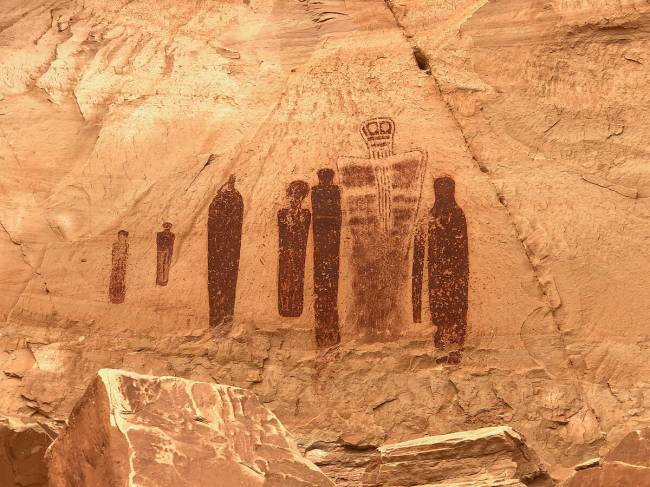
The Great Gallery in Utah’s Canyonlands National Park is revered for its grandeur and pictographs, believed to be between 1,500 and 4,000 years old. Making one’s way toward the expansive displays can feel a bit like traveling back through the centuries. As the historic etchings come into view, footsteps crunching on the sandy earth are likely to be the only sounds piercing the vast silence (although an occasional wild burro may bray suddenly to announce its presence, as happened on a recent afternoon).
There are actually several panels along different trails, each depicting various animals and human figures. But it’s the Great Gallery in Horseshoe Canyon, measuring 200 feet long by 15 feet high, that has the most elaborate examples of what’s known as Barrier Canyon-style rock art.
Getting to the site, however, requires some diligence. Nearly 500 miles from Las Vegas, the last leg of the journey takes you on a 32-mile drive down a remote, graded dirt road to Horseshoe Canyon. Once you arrive at the rim of the canyon, the rest of the trip is on foot.
Hardy hikers will need to descend 660 feet and trek the 3.5 miles through sandstone and dry washes before reaching the Great Gallery.
There’s no cell service for miles, so whether or not you’re looking for a technology-free getaway, there’s no accessing social media or email. Traveling with friends and taking more than one car is highly recommended to avoid being stranded in case of car trouble. (Cars should be high clearance or four-wheel drive to handle the bumpy, unpredictable road conditions). Rangers lead guided walks in spring and fall, which is the best time to visit, as the punishing heat and elevation can challenge even the most experienced hikers. No matter when you go, bring more water than you think you’ll need. For those hiking the 7-mile round trip, at least a gallon per person is recommended as the journey can take between six and eight hours.
How to get there from Las Vegas: Take I-15 N and I-70 E to UT-24 W in Emery County. Take W. Lower San Rafael Road, Roost Road and NationalPark/Recreation Road 777 and follow the signage. Checking road conditions is a must, and updates are available by calling (435) 259-2652 between 8 a.m. and 4:30 p.m. Camping in Horseshoe Canyon is prohibited, but there are some campsites on public land at the west rim trailhead. Visit nps.gov for more information.














